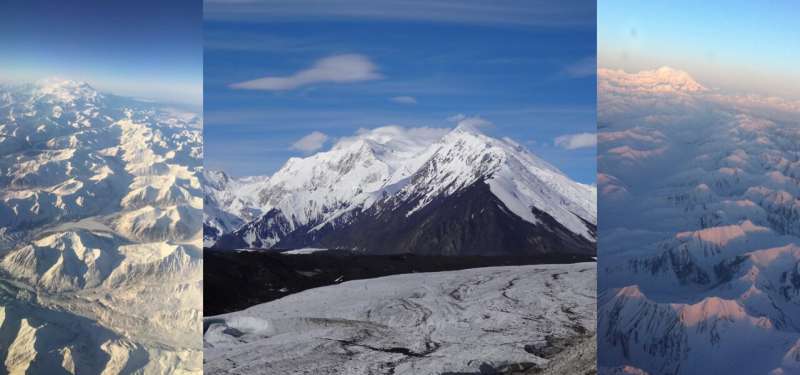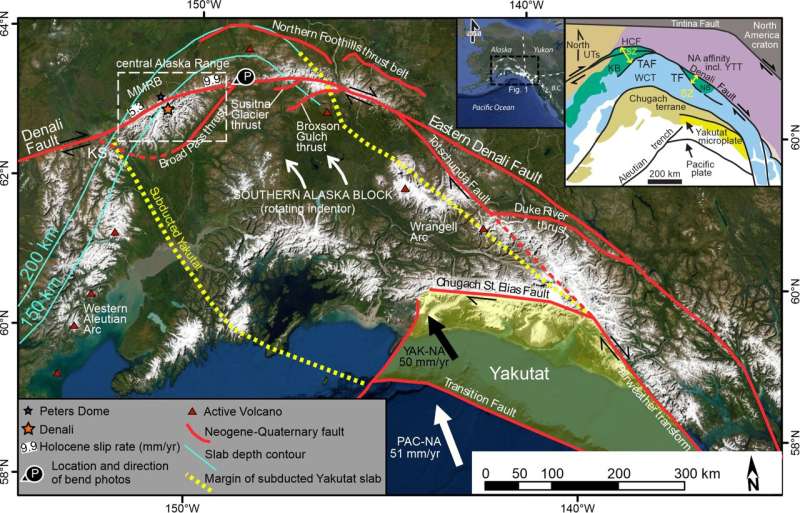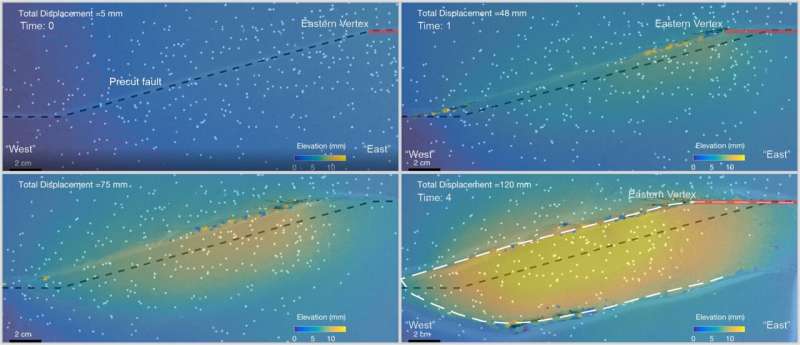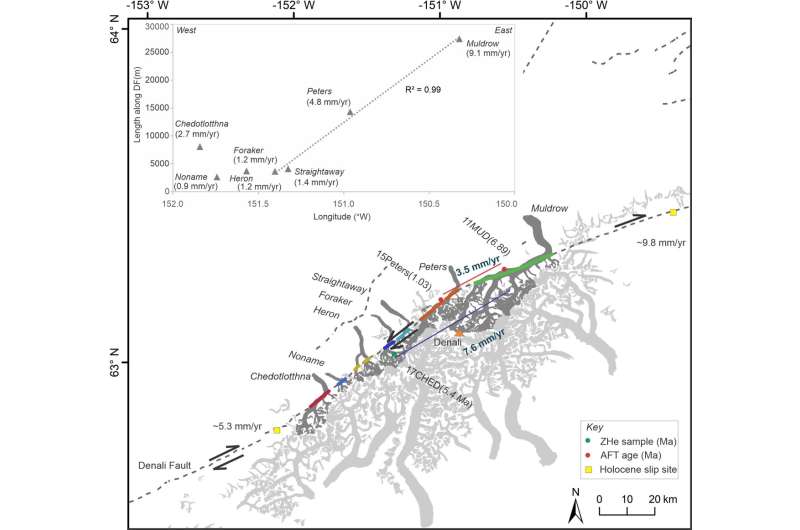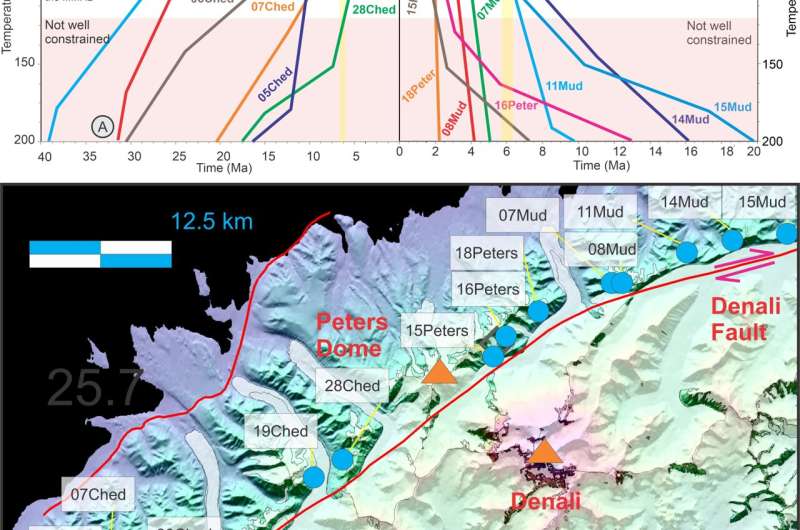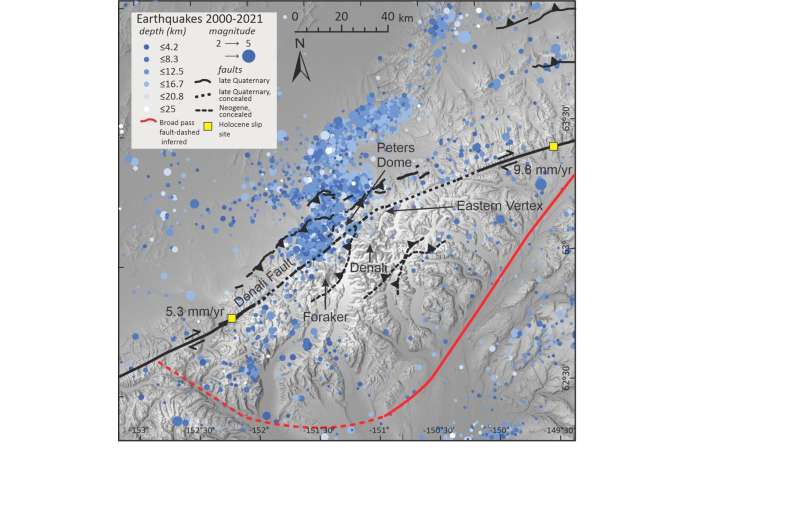Photographs of Mount Denali and Muldrow Glacier. Mount Denali (6194 m; 20,310 feet; formerly known as Mount McKinley). Denali Bend key, Mount Denali (6194 m; 20,310 feet; formerly known as Mount McKinley) and the Mount McKinley restraining bend. Photo credit: Jeff A. Benowitz, Wiley Terra Nova, doi: 10.1111/ter.12571
In their recent publication, "Why is Denali (6,190 m) so big? Caught inside the tectonic wake of a migrating restraining bend," Jeff A. Benowitz and a research team from the University of Massachusetts Amherst, Virginia Tech, and the South Dakota School of Mines and Technology in the U.S., documented the evolution of the Mount McKinley bend of the Denali Fault.
The researchers used scaled physical experiments, thermochronology, seismicity patterns and fault slip rate data to come up with a whole new geologic process to explain the geo-enigma of Mount Denali and Mount Foraker (5304 m), which had hitherto baffled researchers for generations. Primary author of the study Jeff A Benowitz describes Denali, previously also known as Mount McKinley, as an albino moose of the Alaska Range, taller by three thousand feet and broader than all other peaks of the Range.
Moreover, this is the highest peak in North America. Metrologists have often claimed that the mountain is big enough to create its own weather. According to Dr. Benowitz, "Famous artists, the like of Sydney Laurence, Ansel Adams and even Bob Ross, have been drawn to capture the light and shadows of Denali's glaciated slopes."
The heights of Denali have fascinated geologists for more than 100 years, and geologists have described and named the fissure running along the north base of the Mountain, as the Denali Fault, and linked the topographic development of the Alaska Range with the geological structure. The study is now published in Wiley Terra Nova.
The geo-enigma of Mount Denali
The broad Denali massif (20,310 feet) is a geo-enigma since its located along the Denali Fault, which is a strike-slip fault geologic structure with primary horizontal motion, much like the San Andreas. Kinks or restraining bends along strike-slip faults can lead to the creation of mountains as these geometric features lead to the transfer of a component of the horizontal motion into a vertical component and Denali is located within the Mount McKinley restraining bend.
However, topography along strike-slip fault restraining bends is theoretically self-limited by erosion and translation of crustal blocks through regions of focused vertical tectonics. The unusual topographic high of the region is further highlighted by how such a mountain could form along a fault bend itself given the transient nature of these features and how they should not persist for millions of years as it has thus far. In this work, a team of interdisciplinary scientists discovered and documented a new geologic process, migrating low-angle restraining bends, and highlighted characteristics of these bends to provide tests to find out if other regions of extreme topographic elements along strike-slip faults were also products of migrating restraining bends. To accomplish this, Jeff A. Benowitz, a multiple-Denali summiteer himself, acquired funding from the National Science Foundation, and assembled a team of physical modelers, structure geologists, neotectonic researchers and a glaciologist to address this scientific "whatdunnit."
-
Satellite image of south-central Alaska showing the locations of Neogene-Quaternary fault systems discussed in the text, subducted and un-subducted portions of the Yakutat microplate, active volcanoes (<10,000 ka). Inset maps show image location in western North America and the terrane geology in the region of the satellite image. Denali Fault Holocene slip rates from Haeussler, Matmon, et al. (2017). PAC-NA and YAK-NA vectors from Elliot et al. (2010). Margin of subducted Yakutat microplate based chiefly on tomography and seismicity data (adapted from Eberhart-Philips et al., 2006; Bauer et al., 2014; Wech, 2016). Inset on upper right shows Cretaceous suture zone separating Insular terranes from inboard terranes and terrane bounding structures. HCF, Hines Creek fault; KB, Kahiltna basin; KS, Kichatna Spires; NA, North America; SZ, Alaska Range Suture zone; TAF, Talkeetna fault; TF, Totschunda fault; UTs, unidentified terranes and sedimentary rocks; YTT, Yukon-Tanana terrane; WCT, Wrangellia composite terrane. Credit: Wiley Terra Nova, doi: 10.1111/ter.12571
-
Snapshots of cumulative uplift of experiment simulating the Mount McKinley restraining bend (MMRB) overlain on photos of the experiment at four stages in the experiment. The marked cardinal directions refer to the orientation of the Mount McKinley structure. In the experiment, the southern plate displaces westward relative to the northern plate and the dashed lines show the initial position of the restraining bend; the eastern vertex drifts to the left (“west”) relative to the northern plate. The dashed white line represents the final position of the MMRB and the master thrust fault that develops to the “south.” Credit: Wiley Terra Nova, doi: 10.1111/ter.12571
-
Glacial outlines of the Mount McKinley restraining bend (MMRB; Pfeffer et al., 2014) with length glaciers travels along the Denali Fault presented as coloured lines. Slip vector arrows are pointed in the same direction west of the eastern vertex of the MMRB, because the eastern vertex of the bend is migrating to the west. Holocene slip rates are from Haeussler, Matmon, et al. (2017). Thermochronology calculated slip rates on the northside of the Denali Fault capture the rate that the eastern vertex is migrating to the west (3.5 mm/year). This time-space averaged slip rate does not take into account the large uncertainty with apatite fissiontrack (AFT) data but is within the eastern vertex migrating range of 2–6 mm/year calculated by Burkett et al. (2016). Thermochronology calculated slip rates on the southside are based on the separation since 6 Ma of the two swaths of ~6 Ma cooling ages on both sides of the Denali Fault (7.6 mm/year). This slip rate is not only time averaged, but also space averaged as the rate of separation decreases to the west through the bend. This time-space averaged slip rate does not take into account the large uncertainty with AFT and ZHe data, but is consistent with the Holocene slip rates of ~10 mm/year (east end) from Haeussler, Matmon, et al. (2017) and the rates calculated using glacial length along the Denali Fault (inset plot). The length the MMRB glaciers travel along the Denali Fault was measured and divided by 3 Ma to calculate a slip rate since the start of valley glaciers in interior Alaska (e.g., Benowitz et al., 2011). Rates decrease from east to west as the southern Alaska Block is advected into the MMRB and then increase again west of the bend. This slip rate trend aligns with the physical models, whereas separation rates are slower in the region where both sides of the Denali Fault are laterally advecting in the same direction. The linear regression is only for Muldrow to Foraker glacier segment and this section has a glacial length weighted slip rate of 6.7 mm/year similar to the thermochronology constraint for this fault section (~7.6 mm/year) Credit: Wiley Terra Nova, doi: 10.1111/ter.12571
Field experiments to understand geologic structures
Co-authors Cooke and Toeneboehn of the University of Massachusetts conducted scaled physical experiments to show that low angle restraining bends could persist through time by migrating in a sole direction, alongside modeling that mimicked the natural topography and slip rate patterns of the Mount McKinley bend. Thermochronology data, produced by Dr. Metcalf of CU Boulder and co-author O'Sullivan of GeoSeps services indicated rapid deformation on the north side of the Mount McKinley bend, initiated to the east and before progressing to the west, constraining the timing of bend formation to 6 million years ago. The timing of bend formation aligns with the independently determined 6 million years ago initiation timing of rapid Denali uplift determined by Dr. Fitzgerald of Syracuse University in 1993. Benowitz's team also found that Mount Foraker in the Central Alaska range, 14 miles southwest of Denali, has experienced more exhumation than Denali because it has been trapped in the Mount McKinley bend for a longer period of time. Co-author Bemis of Virginia tech documented seismic activity is concentrated to the west of the eastern vertex of the bend as the crust is buckling in response to the deforming and migrating Mount McKinley bend. Glaciologist Herried with lead author Benowitz showed the geomorphology of the glaciers along the McKinley bend also to be affected by the migration of the bend with glaciers traveling further along the Denali Fault trench when horizontal displacement rates are higher. Based on the results, the scientists showed that the low angle (18 degrees) McKinley bend formed 6 million years ago and had persisted through migration of the eastern vortex of the bend to the west. Jeff Benowitz explains that 'as the fault moves at an average rate of five to ten millimeters (about a quarter inch) a year, the mountain is essentially "stuck" inside this bend because the vertex of the bend is also moving west (at a slightly slower rate of about three millimeters a year)." As a result, he continues, "Mount Foraker (17,400 feet, 5304 meters) is essentially a paleo-Denali."
-
(a) Weighted mean paths of HeFTy inverse models of apatite fission-track and ZHe data north of the Mount McKinley restraining bend (MMRB). Distal from the Denali Fault trace sample 22, Peter not included in figure for clarity. Right panel demonstrates original position of the MMRB eastern vertex through an increase in rock cooling rates after ~6 Ma and westward progression of initiation of rapid cooling after formation of the MMRB. Left panel demonstrates samples west of the deformation front of the westward migrating eastern vertex of the MMRB have slower rock cooling trajectories. Furthermore, north of the Denali Fault rock cooling trajectories are slower to the west of the eastern vertex of the MMRB compared to the east. Hence, cooling age patterns along the MMRB are reflecting a migrating restraining bend and not simply differential degrees of overall exhumation. Circles have angle of representative rock cooling trajectories and associated time-average cooling rates. Below the partial annealing zone for apatite fission track analysis (~120°C), HeFTy inverse models are not well constrained unless ZHe data were available for modelling. (b) Digital elevation model of the MMRB with sample locations plotted on Figure (a) annotated. Credit: Wiley Terra Nova, doi: 10.1111/ter.12571
-
Active structural features and crustal seismicity of the Mount. McKinley restraining bend (MMRB; modified from Burkett et al., 2016). Earthquakes shown are a subset from 2017–2021 of the full Alaska earthquake data set and shown with a minimum depth of 2 kms and a maximum depth of 25 kms (ComCat; https://earthquake.usgs.gov/earthquakes/search/). Hypocenters are coloured by depth with a blue gradient indicating increasing depth to a maximum of 25 kms. Slip rate constraints shown for the nearest sites east and west of the MMRB (Haeussler, Matmon, et al., 2017) Credit: Wiley Terra Nova, doi: 10.1111/ter.12571
Outlook: Sustaining the elevation of Denali and Foraker
More information: Jeff A. Benowitz et al, Why is Denali (6,194 m) so big? Caught inside the tectonic wake of a migrating restraining bend, Terra Nova (2021). DOI: 10.1111/ter.12571
Kevin Toeneboehn et al, Stereovision Combined With Particle Tracking Velocimetry Reveals Advection and Uplift Within a Restraining Bend Simulating the Denali Fault, Frontiers in Earth Science (2018). DOI: 10.3389/feart.2018.00152
© 2021 Science X Network
